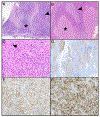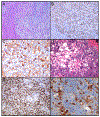Thymic Carcinomas-A Concise Multidisciplinary Update on Recent Developments From the Thymic Carcinoma Working Group of the International Thymic Malignancy Interest Group
- PMID: 35227908
- PMCID: PMC11080660
- DOI: 10.1016/j.jtho.2022.01.021
Thymic Carcinomas-A Concise Multidisciplinary Update on Recent Developments From the Thymic Carcinoma Working Group of the International Thymic Malignancy Interest Group
Abstract
Thymic carcinomas are rare malignancies that in general arise in the prevascular (anterior) mediastinum. These tumors are usually invasive, often present at advanced stages, and typically behave aggressively. Studies are hampered by the paucity of these tumors, the large variety of carcinoma subtypes, and the lack of unique morphologic and immunophenotypic features. Despite these challenges, advances in diagnostic imaging, surgical approaches, systemic therapies, and radiation therapy techniques have been made. The WHO classification of thymic epithelial tumors has been updated in 2021, and the eighth tumor nodal metastasis staging by the American Joint Committee on Cancer/Union for International Cancer Control included thymic carcinomas in 2017. Molecular alterations that provide more insight into the pathogenesis of these tumors and that potentially permit use of novel targeted therapies are increasingly being identified. New approaches to radiation therapy, chemotherapy, and immunotherapy are under evaluation. International societies, including the International Thymic Malignancy Interest Group, European Society of Thoracic Surgeons, and Japanese, Chinese, and Korean thymic associations, have been critical in organizing and conducting multi-institutional clinical studies. Herein, we review contemporary multidisciplinary perspectives in diagnosis and management of thymic carcinoma.
Keywords: ITMIG; International Thymic Malignancy Interest Group; TNM staging; Thymic carcinoma; WHO.
Copyright © 2022 International Association for the Study of Lung Cancer. All rights reserved.
Figures





References
-
- Koizumi T, Otsuki K, Tanaka Y, et al.: National incidence and initial therapy for thymic carcinoma in Japan: based on analysis of hospital-based cancer registry data, 2009-2015. Jpn J Clin Oncol 2020, 50:434–9. - PubMed
-
- Roden AC, Fang W, Shen Y, et al.: Distribution of Mediastinal Lesions Across Multi-Institutional, International, Radiology Databases. J Thorac Oncol 2020, 15:568–79. - PubMed
Publication types
MeSH terms
Grants and funding
LinkOut - more resources
Full Text Sources
Medical

